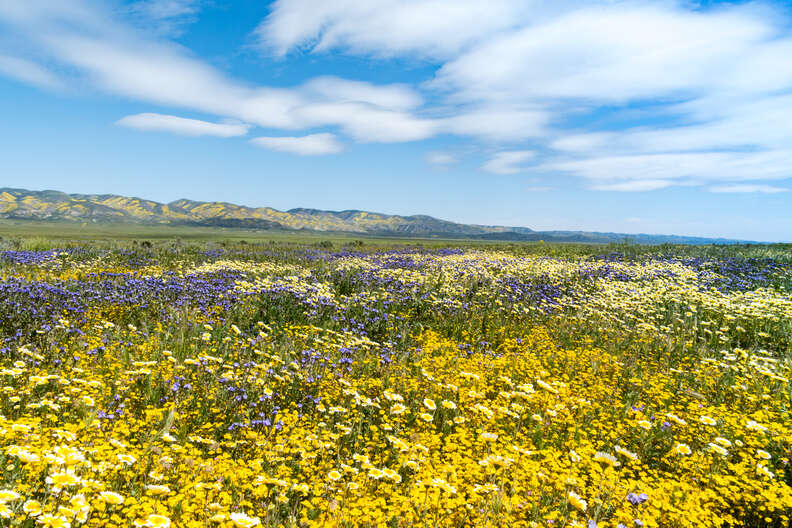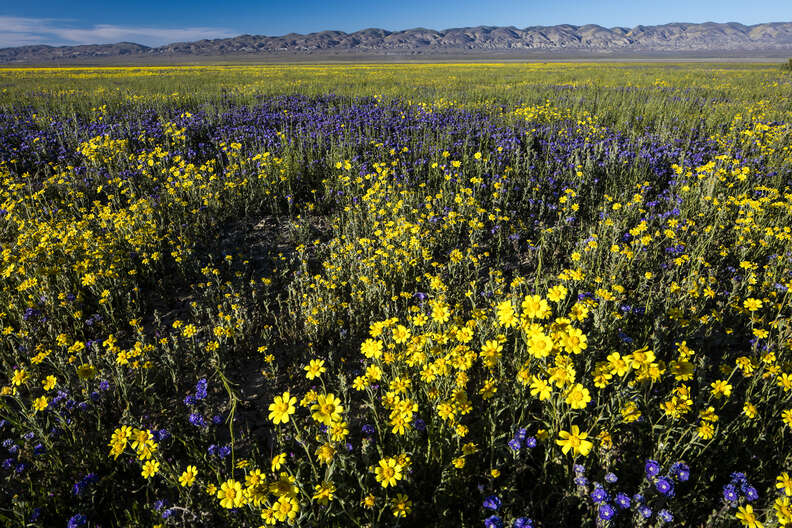How to Responsibly Immerse Yourself in LA Wildflowers During the Superbloom
Spring has sprung in Southern California, and the hills, bluffs, fields, and trails are bursting with gorgeous wildflowers.

This February wasn’t the wettest one of all time in LA, but it wasn’t far off, either, thanks to one particularly massive storm and regular appearances from atmospheric rivers. There is a silver lining to all of that precipitation, though: it sets us up for a big wildflower bloom this spring. We may not reach the epic superbloom of a few years ago, but the hills will nonetheless be alive with polychromatic wildflower blossoms. To make the most of this spectacular season, we’ve put together an explainer on the best places to see a superbloom around LA, from great local hikes to desert drives. And we’ve got some tips on ensuring you’re an ethical, responsible, and wise flower finder, too.
There will be fields of California poppies, undulating blocks of electric coral like crushed ice at the bottom of a cup of Orange Bang. But as the Executive Director of the Theodore Payne Foundation Evan Meyer told Thrillist in 2023, he gets most excited about the kaleidoscopic array of native plants that will light up the hills. “Going out in the spring and saying, ‘Hey there are 30 different types of flowers that all look different’—being able to appreciate that diversity is a big part of it,” he says.
Meyer is a botanist, so he’s just as happy spotting a single oddball plant, maybe a particularly shapely Ceanothus or a surprisingly tall Owl’s Clover, as he is marveling at a whole hillside of a single flower. And the rest of us should take a lesson there, too. It’s easy to get lost in the splashy photos of high desert hillsides full of flowers, but there is thrilling beauty to be found in patches and spots all over the region, sprouting along trails, in parks, next to freeway onramps, and in any open space that gets reasonable water and sun.
Southern Californians have access to a wide variety of subclimates. There are deserts, mountains, and coastline, each of which has its own set of wildflowers that will bloom this spring and each of which holds untold beauty to discover.
Meyer says that searching for wildflowers “is a really incredible and special event, and it’s something that makes it wonderful to live in Southern California,” but there’s one important caveat: “It’s also something that we have a responsibility to do ethically.”

To that end, Meyer has a few general rules for ethically, sustainably, and responsibly seeing the superbloom in Southern California:
1. Always stay on trails. As Meyer puts it, “These plants are very sensitive to being walked on, and if you go out to get the perfect selfie you’re going to kill a bunch of plants, diminish the next superbloom, and diminish this year’s for everyone else.”
2. Don’t pick flowers. “The flowers are creating the next superloom this season,” Meyer says. “This mass bloom of flowers means a mass production of seeds, and at the end of the season those seeds are going to fall into the ground to await the next year to redo the whole cycle. So if you’re out there picking flowers, you’re removing seeds from that environment, and if a bunch of people do that it’s going to have a really detrimental effect.”
3. Be a good visitor. It’s important to remember that people still live, work, and spend time in these places year-round, so when you drive out from the city into a more remote area, keep the essentials in mind: “Be respectful, carry your trash out, just basically be a decent human,” Meyer says.
Meyer has one other guideline that’s more for your own sanity than anything else: “If you’re seeing it trending on social media, it’s probably not where you want to be.”
A potential superbloom will generate tons of interest from across the region and beyond. The hotspots are likely to be crowded, congested, and chaotic, especially in the more remote places that aren’t designed to handle a sudden massive influx of visitors. Instead, he says, you may benefit from focusing on the quieter areas. Look on riverbanks and in meadows along any trail you like, and take in the extensive scope of blooms but also the individual plants. “The more you are willing to search and seek out,” says Meyer, “the more inspiring it’s going to be.”
For the latest updates on all things wildflowers, the Theodore Payne Foundation’s much-loved Wild Flower Hotline is live for 2024. Each Friday into late May, the foundation will post a recorded message detailing the status of wildflowers at various locations across Southern and Central California, from local LA spots to destination fields all over the region. All you have to do is call 818-768-1802 extension 7 to get the latest intel.
In the meantime, we’ve compiled a short list with Meyer’s help, featuring a few great places to see the superbloom near LA.
Where to See the Wildflower Superbloom 2024
Tarzana
If you cruise along Reseda Boulevard in Northridge, it’s hard to picture the wide, busy industrial street taking you anywhere that could be called picturesque. But if you follow the road south, it eventually winds up into the Santa Monica Mountains, where it shrinks and peters out into the dirt at the Top of Reseda Trailhead. From the parking lot, tons of trails branch off and crisscross the expansive Mulholland Gateway Park, and it’s one of Meyer’s favorite local places to explore. Already, he says, the ceanothus has been going crazy, painting the hillsides white, and clarkias and more are now joining them.

Pasadena
The San Gabriel Mountains are a treasure, a vast and verdant range with fantastic hiking, camping, biking, and more. Wildflowers will bloom throughout the mountains this season and well into summer at higher elevations. But you don’t have to drive way up into the mountains to find flowers. Eaton Canyon is at the top of Pasadena, right at the base of the San Gabriels, and it’s a lovely place to poke around, take a relatively easy hike and examine lots of blooming flowers on your way to the justifiably beloved 40-foot waterfall at the end of the trail.

Malibu
With cooler temperatures and gorgeous ocean views, the coastal bluffs around Malibu are some of the most beautiful places to see wildflowers. Charmlee Wilderness Park covers some 532 acres of hiking trails, picnic areas, and open space off of Encinal Canyon Road overlooking the spectacular coastline. The hiking is pretty easy and trails are well-established, so it’s a great place for a casual hike on your way to or from the beach. And you absolutely cannot beat the smell of Pacific Coast plant life, sage and brush mixed with salty ocean air.

Eastern San Luis Obispo County
If you’re looking for the full kaleidoscopic majesty of a superbloom, Carrizo Plain may be your best bet. The arid plain is about three hours north of LA in the San Joaquin Valley. Though it’s dry and dusty for much of the year, it explodes in color after a wet winter and provides a little glimpse into what the valley may have looked like before becoming the modern-day center of industrial agriculture. Carrizo Plain flies a little under the radar relative to some other spots, so it’s a great option if you’ve got the time to get out of the city.

Eastern San Diego County
The vast desert park has grown particularly famous for wildflowers after the true superbloom of 2017, but even when things don’t rise to that level, there are gorgeous flowers to be found here. It’s about a three-hour drive from LA, and it’s worth checking their website to see which parts of the park have wildflowers before you set out. As of early March, sand verbena, desert sunflower, and desert primrose were in bloom at various locations, with more coming through the spring.
Riverside County
For an easy, kid-friendly wildflower hike, head out to deep Riverside County to check out Diamond Valley Lake and their wildflower trail. The well-marked path is about two miles long, looping around the sloping hills next to lovely Diamond Valley Lake, with the option to extend the hike further along the lakeside if you want. You pay to park, and there’s no shade to speak off, which can make the hike hot but also keeps the views pristine.
San Bernardino County
The LA-adjacent side of the Inland Empire is known for asphalt sprawl, but Chino Hills State Park is an emerald jewel in the southwest corner of San Bernardino County. The park has some 90 miles of hiking trails, and in the spring the hills burst into bloom with all of the native wildflowers the basin has to offer. You are likely to see poppies, of course, and also lupine and sunflowers among many others, and you can make a hike in Chino Hills State Park as challenging or as chill as you’d like, from mellow Telegraph Canyon to the more strenuous South Ridge Trail up to San Juan Hill.
Santa Clarita Valley
Head north through the San Fernando Valley to Placerita Canyon for a peaceful hik through oak groves and chaparral. The nature center is a good base of operations, and along nearby trails you can expect to see peonies, purple nightshades, and more. The Ecology Trail is a pleasant and short stroll, and when the water level settles down a little after all the winter rain, the Canyon Trail will reopen for more great hiking.